GE WNRD2050 Owner’s Manual

<![endif]>Washers
ge.com
Safety Information . . . . . . . . . .2, 3
Operating Instructions
Control Panel . . . . . . . . . . . . . . . . . . . . . .4
Control Settings . . . . . . . . . . . . . . . . . . .5
Loading and Using
the Washer . . . . . . . . . . . . . . . . . . . . .6, 7
Washer Features . . . . . . . . . . . . . . . . . .6
Troubleshooting Tips . . . . . .8–12
Consumer Support
Consumer Support . . . . . . .Back cover Product Registration . . . . . . . . . .13, 14 Warranty . . . . . . . . . . . . . . . . . . . . . . . .16
Owner’s Manual
WNRD2050
Laveuses
Manuel d’utilisation
La section française commence à la page 17
Lavadoras
Manual del propietario
La sección en español empieza en la página 33
Write the model and serial numbers here:
Model # ________________
Serial # ________________
You can find them in the upper right corner on the back of your washer.
175D1807P590 49-90322-1 12-07 JR
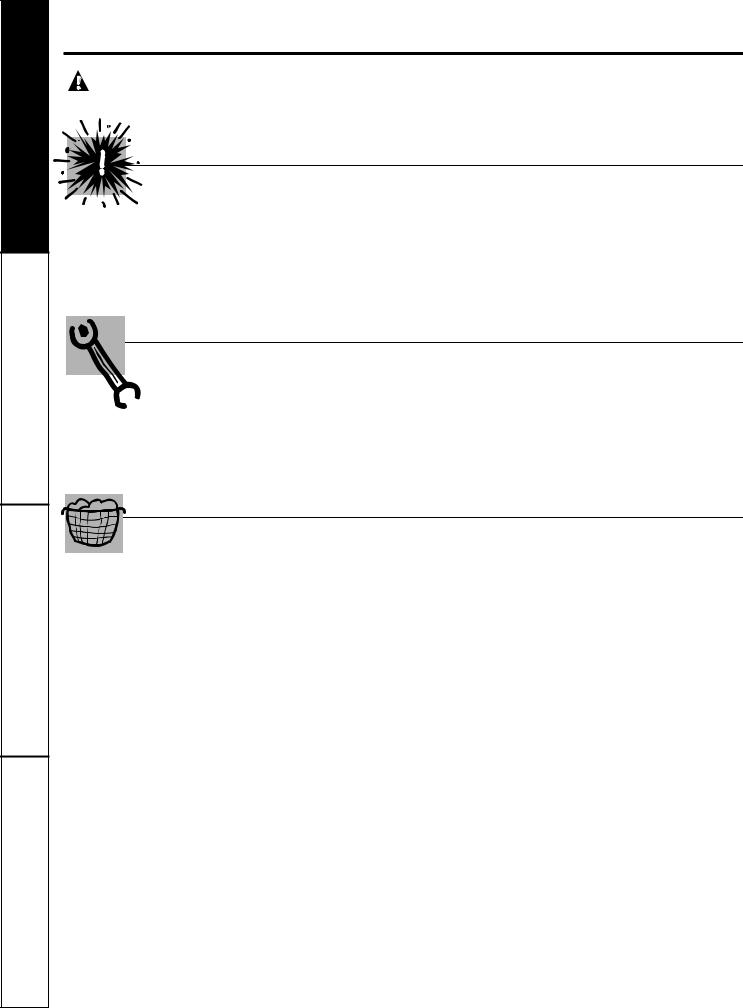
<![endif]>Safety Instructions
<![if ! IE]><![endif]>Operating Instructions
<![if ! IE]><![endif]>Troubleshooting Tips
<![if ! IE]><![endif]>Consumer Support
IMPORTANT SAFETY INFORMATION.
READ ALL INSTRUCTIONS BEFORE USING.
WARNING! For your safety, the information in this manual must be followed to minimize the risk of fire or explosion, electric shock, or to prevent property damage, personal
injury, or loss of life.
 WATER HEATER SAFETY
WATER HEATER SAFETY
Under certain conditions hydrogen gas may be produced in a water heater that has not been used for two weeks or more. Hydrogen gas can be explosive under these circumstances.
If the hot water has not been used for two weeks or more, prevent the possibility of damage or injury by turning on all hot water faucets and allowing them to run for several minutes. Do this before using any electrical appliance which is connected to the hot water system. This simple procedure will allow any built-up hydrogen gas to escape. Since the gas is flammable, do not smoke or use an open flame or appliance during this process.
PROPER INSTALLATION
This washer must be properly installed and located in accordance with the Installation Instructions before it is used. If you did not receive an Installation Instructions sheet, visit our Website at: ge.com.
■Install or store where it will not be exposed to temperatures below freezing or exposed to the weather.
■Remove the colored protective film from the control panel.
YOUR LAUNDRY AREA
■Properly ground washer to conform with all governing codes and ordinances. Follow details in Installation Instructions.
■ Keep the area underneath and around your |
■ Close supervision is necessary if this appliance is |
appliances free of combustible materials such |
used by or near children. Do not allow children to |
as lint, paper, rags, chemicals, etc. |
play on, with, or inside this or any other appliance. |
2
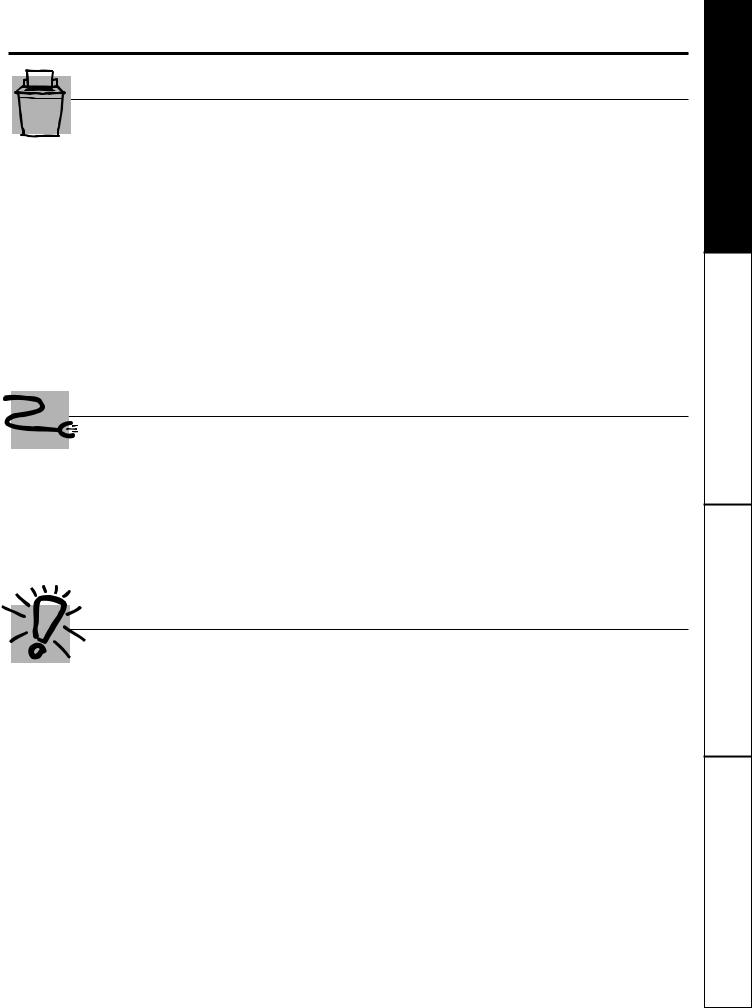
Use this appliance only for its intended purpose as described in this Owner’s Manual.
WHEN USING THE WASHER
■Never reach into washer while it is moving. Wait until the machine has completely stopped before opening the lid.
■Do not mix chlorine bleach with ammonia or acids such as vinegar and/or rust remover. Mixing different chemicals can produce a toxic gas which may cause death.
■Do not wash or dry articles that have been cleaned in, washed in, soaked in, or spotted with combustible or explosive substances (such as wax, oil, paint, gasoline, degreasers, dry-cleaning solvents, kerosene, etc.) which may ignite or explode. Do not add these substances to the wash water. Do not use or place these substances around your washer or dryer during operation.
■The laundry process can reduce the flame retardancy of fabrics. To avoid such a result, carefully follow the garment manufacturer’s wash and care instructions.
■To minimize the possibility of electric shock, unplug this appliance from the power supply or disconnect the washer at the household distribution panel
by removing the fuse or switching off the circuit breaker before attempting any maintenance or cleaning. NOTE: Pressing PAUSE or STOP/CANCEL does NOT disconnect the appliance from the power supply.
■Never attempt to operate this appliance if it is damaged, malfunctioning, partially disassembled, or has missing or broken parts, including a damaged cord or plug.
WHEN NOT IN USE
■Turn off water faucets to relieve pressure on hoses and valves and to minimize leakage if a break or rupture should occur. Check the condition of the fill hoses; they should be replaced every 5 years.
■Before discarding a washer, or removing it from service, remove the washer lid to prevent children from hiding inside.
■Do not attempt to repair or replace any part of this appliance unless specifically recommended in this Owner’s Manual, or in published user-repair instructions that you understand and have the skills to carry out.
■Do not tamper with controls.
READ AND FOLLOW THIS SAFETY INFORMATION
CAREFULLY.
SAVE THESE INSTRUCTIONS
3
<![endif]>Instructions Safety
<![if ! IE]><![endif]>Instructions Operating
<![if ! IE]><![endif]>Tips Troubleshooting
<![if ! IE]><![endif]>Support Consumer
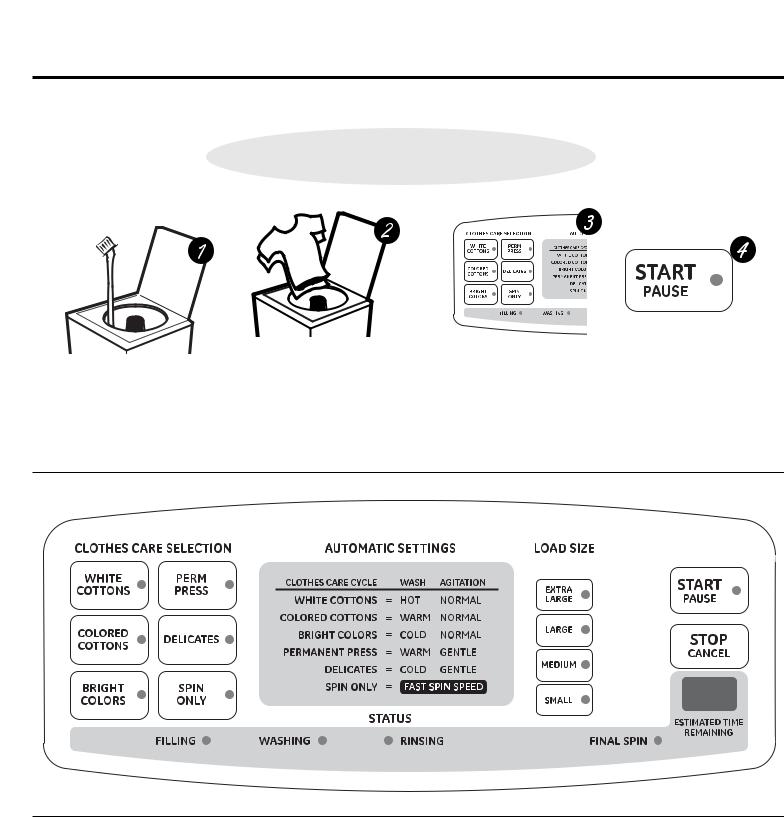
About the control panel.
Your new washer offers the convenience of starting your wash loads by simply choosing a CLOTHES CARE SELECTION. Then all you have to do is press START.
Quick Start Guide
|
• Close lid |
• Add clothes |
• Select wash cycle |
• Add detergent |
• Push START |
• Check load size setting |
For best results, GE recommends use of dryer sheets to freshen clothes and reduce static cling. If you prefer to use liquid fabric softener, please add near the end of the wash (agitate) portion of the cycle, before the water drains. The “washing” light will flash when it is time to add fabric softener. Use of liquid fabric softener during the low-water, high-efficiency rinse can cause spotting on clothes. Rewashing will remove these spots.
Vision-Impaired Washer/Dryer Kit
For washer model WNRD2050 and dryer model DNCD450, a kit is available for the vision-impaired containing Braille overlays that fit over the pads on the washer and dryer control panels.
Included in the kit are:
■Braille overlays for the washer and dryer control panels
■Braille Reference Keys that explain the operation of the washer and dryer
■Use and Care Audio Tape
Order publication number 14-D242, available from your GE supplier.
4
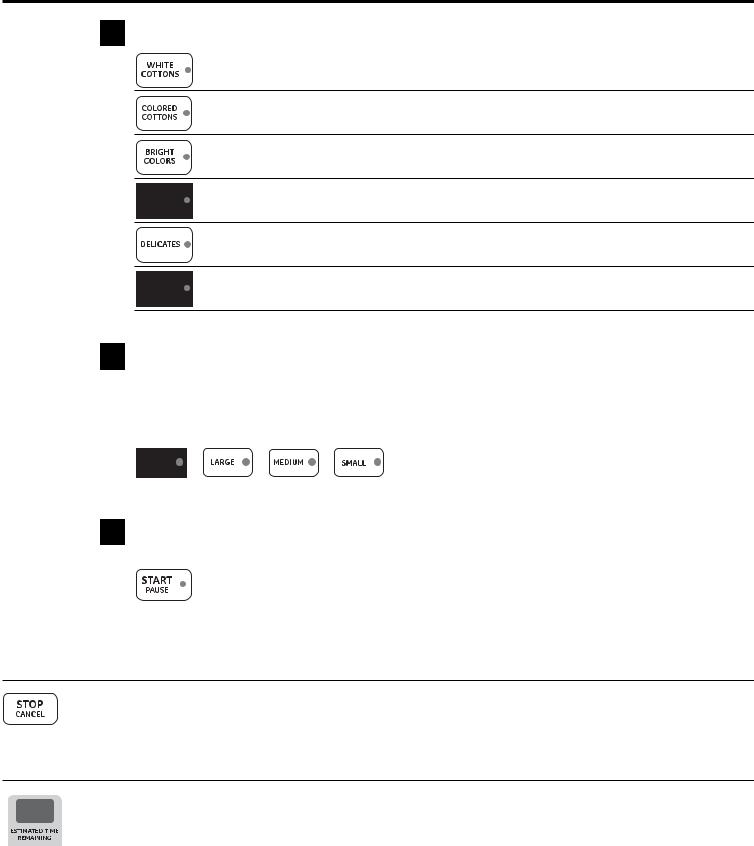
About the control settings.
1CLOTHES CARE SELECTION
For heavily to lightly soiled cottons, household linens, work and play clothes.
For heavily to lightly soiled cottons, household linens, work and play clothes.
For non-colorfast cottons and blends, and items that are labeled cold wash by the fabric manufacturer.
For knits, wrinkle-free and permanent press items.
For lingerie and items labeled delicate with light soils. Provides periods of agitation and soak during wash.
Spin and drain any cycle at any time.
2 LOAD SIZE
A LOAD SIZE setting is automatically set when the CLOTHES CARE SELECTION is chosen. The LOAD SIZE setting can be changed by pressing the pad for the size you want.
Loosely load clothes no higher than the top row of holes in the washer basket. The water level should just cover the clothes.
3 START/PAUSE
Press START to begin the cycle. Pressing START again or raising the lid will PAUSE the cycle.
■Press twice to select the last cycle used and start the washer.
■If the washer is running, press once to interrupt the cycle; press again to continue the cycle.
STOP/CANCEL
This pad should not be used to interrupt or pause a cycle.
Pressing this pad will cancel the current settings and the settings will be lost.
Estimated Time Remaining
■Displays the approximate time remaining until the end of the cycle.
■If the estimated time remaining is more than 60 minutes, “1H” will flash in the display, followed by the additional remaining minutes. When the time remaining is less than 60 minutes, the timer will count down.
■Cycle time is affected by how long it takes the washer to fill. This depends on the water pressure in your home. The “smart” timer “learns” the amount of time it takes to fill your washer and adjusts the total time accordingly.
5
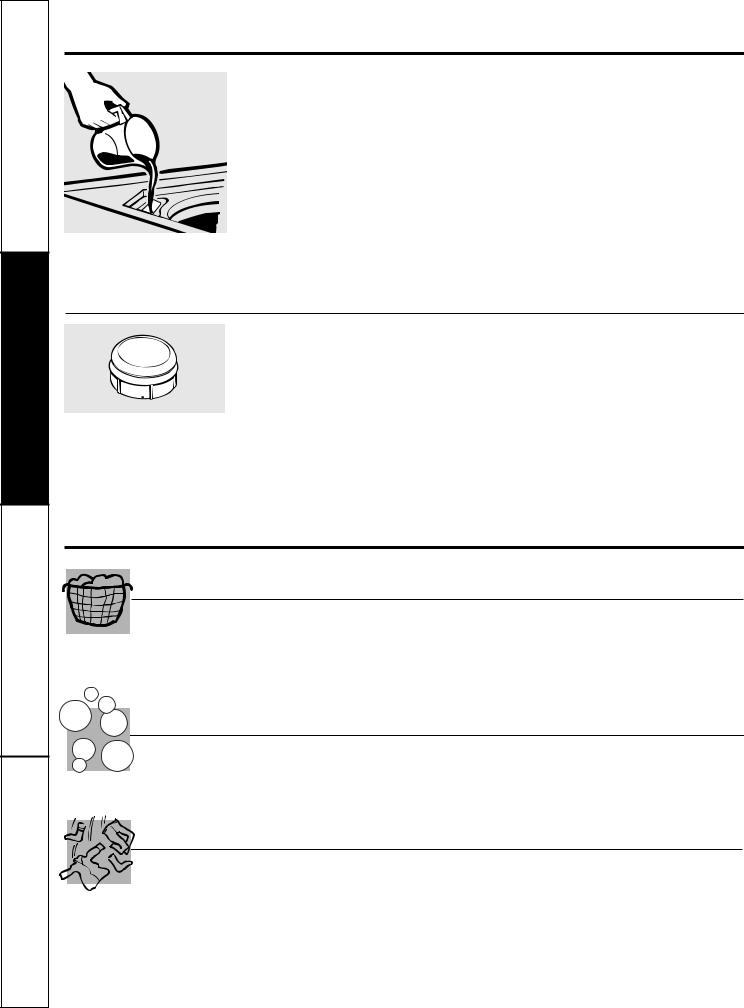
<![endif]>Safety Instructions
<![if ! IE]><![endif]>Operating Instructions
<![if ! IE]><![endif]>Troubleshooting Tips
<![if ! IE]><![endif]>Consumer Support
About washer features.
Liquid Bleach Dispenser
The dispenser dilutes liquid chlorine bleach before it reaches into your wash load.
|
Check clothing care labels for special instructions. |
|
1 |
||
|
Measure liquid bleach carefully, following instructions on the bottle. |
|
2 |
||
|
■ Never pour undiluted liquid chlorine bleach directly onto clothes or into the wash basket. |
|
|
■ Do not pour powdered bleach into bleach dispenser. |
|
|
Before starting the washer, pour measured amount of bleach directly into bleach |
|
3 |
||
dispenser. Avoid splashing or over-filling dispenser. If you prefer to use powdered bleach, |
||
|
add it into the wash basket with your detergent.
■ Do not mix chlorine bleach with ammonia or acids such as vinegar and/or rust remover. Mixing can produce a toxic gas which may cause death.
The Agitator Cap
The agitator cap fits into the top of the agitator. If it accidentally comes off, simply put it back on.
Do not pour anything into the agitator if the agitator cap is removed.
Loading and using the washer.
Always follow fabric manufacturer’s care label when laundering.
Sorting Wash Loads
Sort by color (whites, lights, colors), soil level, fabric type (sturdy cottons, easy care, delicates) and whether the fabric produces lint (terry cloth, chenille) or collects lint (velveteen, corduroy).
Proper Use of Detergent
Using too little or too much detergent is a common |
You can use less detergent if you have soft water, |
cause of laundry problems. |
a smaller load or a lightly soiled load. |
Loading the Washer
Load dry items loosely, no higher than the top row of holes in the washer basket. When loading wet items, make sure you set the load/water level high enough to allow the items to move freely. Water level should just cover the clothes. To add items after washer has started, lift the lid and submerge additional items next to the agitator.
■Do not wrap long items like sheets or pants around the agitator.
■Do not wash fabrics containing flammable materials (waxes, cleaning fluids, etc.).
■Agitation will not start with the lid up.
6
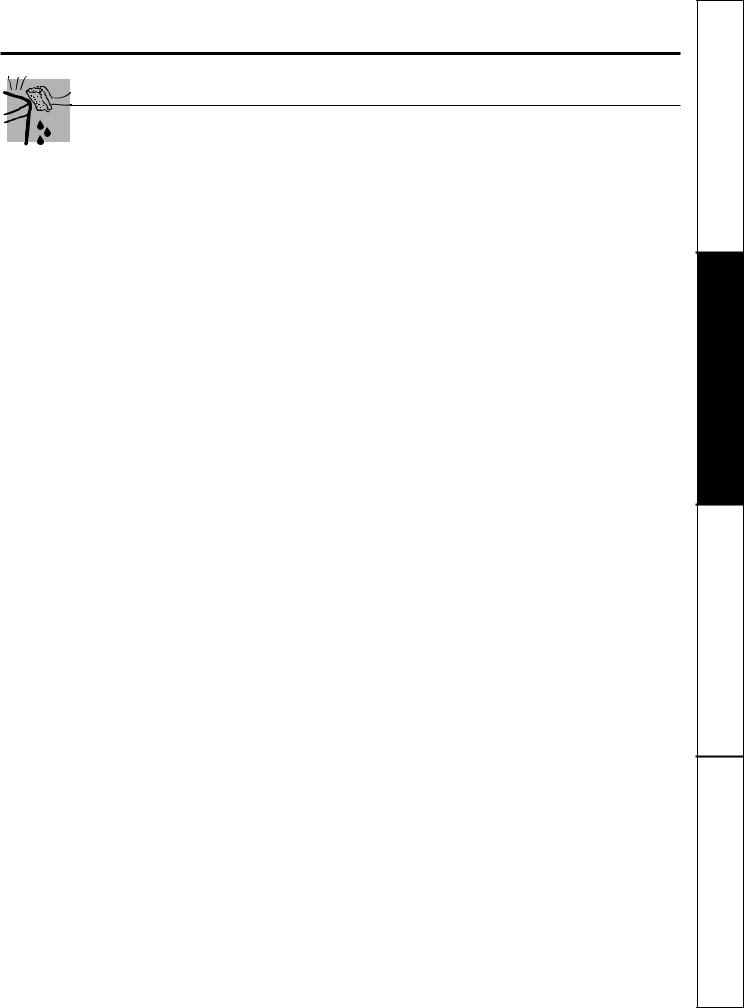
Loading and using the washer.
Always follow fabric manufacturer’s care label when laundering.
Care and Cleaning of the Washer
Wash Basket: Leave the lid open after washing to allow moisture to evaporate. If you want to clean the basket, use a clean soft cloth dampened with liquid detergent, then rinse. (Do not use harsh or gritty cleaners.)
Fill Hoses: Hoses connecting washer to faucet should be replaced every 5 years.
Exterior: Immediately wipe off any spills. Wipe with damp cloth. Try not to hit surface with sharp objects.
Moving and Storage: Ask the service technician to remove water from drain pump and hoses. See the Installation Instructions packed with the product for information on how to reinstall the shipping rod to keep the tub stationary when moving the washer. For more information, visit ge.com, or call 800.GE.CARES (800.432.2737). Do not store the washer where it will be exposed to the weather.
Long Vacations: Be sure water supply is shut off at faucets. Drain all water from hoses if weather will be below freezing.
7
<![endif]>Instructions Safety
<![if ! IE]><![endif]>Instructions Operating
<![if ! IE]><![endif]>Tips Troubleshooting
<![if ! IE]><![endif]>Support Consumer

<![endif]>Safety Instructions
<![if ! IE]><![endif]>Operating Instructions
<![if ! IE]><![endif]>Troubleshooting Tips
<![if ! IE]><![endif]>Consumer Support
Before you call for service…
Troubleshooting Tips
Save time and money! Review the charts on the following  pages first and you may not need to call for service.
pages first and you may not need to call for service.
PERFORMANCE |
|
Possible Causes |
What To Do |
|
|
|
|
Clothes too wet |
|
Water temp selection |
• Some fabrics will feel wetter when rinsed with cold water. |
|
|
|
|
Colored spots |
|
Use of fabric softener |
• For best results, GE recommends use of dryer sheets to |
|
|
|
freshen clothes and reduce static cling. If you prefer to use |
|
|
|
liquid fabric softener, please add near the end of the wash |
|
|
|
(agitate) portion of the cycle, before the water drains. The |
|
|
|
“washing” light will flash when it is time to add fabric |
|
|
|
softener. Use of liquid fabric softener during the low-water, |
|
|
|
high-efficiency rinse can cause spotting on clothes. |
|
|
|
Rewashing will remove these spots. |
|
|
|
|
|
|
Dye transfer |
• Sort whites or lightly colored items from dark colors. |
|
|
|
|
Grayed or yellowed |
|
Not enough detergent |
• Use more detergent (especially with larger loads). Be sure |
clothes |
|
|
to follow detergent manufacturer’s directions. |
|
|
Hard water |
• Use a water conditioner like Calgon brand or install |
|
|
|
a water softener. |
|
|
|
|
|
|
Water is not hot enough |
• Make sure water heater is delivering water at |
|
|
|
120°F–140°F (48°C–60°C). |
|
|
|
|
|
|
Washer is overloaded |
• Select load size to match clothes load. |
|
|
|
|
|
|
Detergent is not |
• Add detergent as wash basket fills with water before |
|
|
dissolving |
you load clothes. |
|
|
|
|
|
|
Dye transfer |
• Sort clothes by color. If fabric label states wash separately, |
|
|
|
unstable dyes may be indicated. |
|
|
|
|
Lint or residue on |
|
Clothes are air or line dried |
• If you do not dry your clothes with a clothes dryer, your |
clothes |
|
|
clothes may retain more lint. |
|
|
|
|
|
|
Incorrect sorting |
• Separate lint producers from lint collectors. |
|
|
|
|
|
|
Detergent not dissolving |
• Add detergent as wash basket fills with water, before you |
|
|
|
load clothes. |
|
|
|
• Try a liquid detergent. |
|
|
|
• Use warmer water temperature. |
|
|
|
|
|
|
Overloading |
• Load clothes no higher than the top row of holes in the |
|
|
|
washer basket. |
|
|
|
• Make sure load size selected matches clothes load size. |
|
|
|
|
|
|
Incorrect use of fabric softener |
• See actions under “Colored spots.” |
|
|
|
|
Pilling |
|
Result of normal wear on |
• While this is not caused by the washer, you can slow the |
|
|
poly-cotton blends and |
pilling process by washing garments inside out. |
|
|
fuzzy fabrics |
|
|
|
|
|
8

PERFORMANCE(cont.) |
|
Possible Causes |
What To Do |
|
|
|
|
Snags, holes, tears, rips |
|
Pins, snaps, hooks, sharp |
• Fasten snaps, hooks, buttons and zippers. |
or excessive wear |
|
buttons, belt buckles, |
• Remove loose items like pins, objects in pockets |
|
|
zippers and sharp objects |
|
|
|
and sharp buttons. |
|
|
|
left in pockets |
|
|
|
• Turn knits (which snag easily) inside out. |
|
|
|
|
|
|
|
|
|
|
|
Undiluted chlorine bleach |
• Check bleach package instructions for proper amount. |
|
|
|
• Never add undiluted bleach to wash or allow clothes |
|
|
|
to come in contact with undiluted bleach. |
|
|
|
|
|
|
Chemicals like hair bleach |
• Rinse items that may have chemicals on them before |
|
|
or dye, permanent wave |
washing. |
|
|
solution |
|
|
|
|
|
Wrinkling |
|
Improper sorting |
• Avoid mixing heavy items (like work clothes) with |
|
|
|
light items (like blouses). |
|
|
|
• Try a fabric softener. |
|
|
|
|
|
|
Overloading or |
• Load your washer so clothes have enough room to move |
|
|
incorrect water level |
freely with water covering all of the clothes. |
|
|
|
|
|
|
Incorrect wash and |
• Match Cycle selection to the type of fabric you are |
|
|
dry cycles |
washing (especially for easy care loads). |
|
|
|
|
|
|
Repeated washing in |
• Wash in warm or cold water. |
|
|
water that is too hot |
|
|
|
|
|
OPERATION |
|
Possible Causes |
What To Do |
|
|
|
|
Washer pauses |
|
The DELICATES cycle was chosen |
• This is normal. The DELICATES cycle has a short soak |
during wash cycle |
|
|
period. |
Washer pauses during |
|
This is normal |
• The washer may pause during the spin cycle to remove |
spin cycle |
|
|
soapy water more efficiently. |
Washer won’t operate |
|
Washer is unplugged |
• Make sure cord is plugged securely into a working outlet. |
|
|
|
|
|
|
Water supply is turned off |
• Turn both hot and cold faucets fully on. |
|
|
|
|
|
|
Controls are not set properly |
• Check controls. |
|
|
|
|
|
|
Lid is open |
• Close lid. |
|
|
|
|
|
|
Circuit breaker/fuse is |
• Check house circuit breakers/fuses. Replace fuses or |
|
|
tripped/blown |
reset breaker. Washer should have separate outlet. |
|
|
|
|
|
|
Electronics need to be reset |
• Unplug washer, wait 2 minutes, plug back in |
|
|
|
and press START. |
|
|
|
|
|
|
START was not pressed |
• Press START. |
|
|
|
|
|
|
Extremely low water pressure |
• Press START again. |
|
|
|
|
|
|
Lid magnet missing |
• Call for service. |
|
|
|
|
9
<![endif]>Instructions Safety
<![if ! IE]><![endif]>Instructions Operating
<![if ! IE]><![endif]>Tips Troubleshooting
<![if ! IE]><![endif]>Support Consumer

<![endif]>Safety Instructions
<![if ! IE]><![endif]>Operating Instructions
<![if ! IE]><![endif]>Troubleshooting Tips
<![if ! IE]><![endif]>Consumer Support
Before you call for service…
Troubleshooting Tips
WATER |
|
Possible Causes |
What To Do |
|
|
|
|
Too many suds |
|
Type of detergent |
• Switch to HE detergent. |
|
|
|
|
|
|
Very soft water |
• Try less detergent. |
|
|
|
|
|
|
Too much detergent |
• Measure your detergent carefully. Use less soap if you |
|
|
|
have soft water, a smaller load or a lightly soiled load. |
|
|
|
|
Water leaks |
|
Fill hoses or drain hose is |
• Make sure hose connections are tight at faucets and |
|
|
improperly connected |
at washer. |
|
|
|
• Make sure end of drain hose is properly connected |
|
|
|
to washer and correctly inserted in and secured to |
|
|
|
drain facility. |
|
|
|
|
|
|
Household drain may |
• Check household plumbing. You may need to call a |
|
|
be clogged |
plumber. |
|
|
|
|
|
|
Constant water pressure |
• Tighten hoses at the faucets and turn the water off after |
|
|
to the fill hoses at the |
each use. |
|
|
water source |
• Check condition of the fill hoses; they should be replaced |
|
|
|
|
|
|
|
every 5 years. |
|
|
|
|
|
|
Using too much detergent |
• Use less detergent. Use less soap if you have soft water, a |
|
|
in washer |
smaller load or a lightly soiled load. |
|
|
|
|
Water temperature |
|
Cooler water temperatures |
• New laundry detergents have been formulated to work |
seems incorrect |
|
provide improved energy |
with cooler water temperatures without affecting wash |
|
|
efficiency |
performance. |
|
|
|
|
|
|
Control is not set properly |
• Check cycle selection and adjust. |
|
|
|
|
|
|
Water supply is turned off |
• Turn both hot and cold faucets fully on and make sure |
|
|
or improperly connected |
hoses are connected to correct faucets. |
|
|
|
|
|
|
Water valve screens are |
• Turn off the water source and remove the water connection |
|
|
stopped up |
hoses from the upper back of the washer. Use a brush or |
|
|
|
toothpick to clean the screens in the machine. Reconnect |
|
|
|
the hoses and turn the water back on. |
|
|
|
|
|
|
House water heater is |
• Make sure house water heater is delivering water |
|
|
not set properly |
at 120°F–140°F (48°C–60°C). |
|
|
|
|
|
|
All the water in your household |
• Wait until the water in the water heater is heated to the |
|
|
water heater has been used |
correct temperature. |
|
|
|
|
Water pumped out |
|
Lid lifted or cycle was put in |
• Reset cycle. |
before cycle is complete |
|
pause for over 24 hours |
|
|
|
|
|
Water won’t drain |
|
Drain hose is kinked or |
• Straighten drain hose and make sure washer is not sitting |
|
|
improperly connected |
on it. |
|
|
|
• Top of drain outlet should be less than 6 ft (1.8 m) |
|
|
|
above floor. |
|
|
|
|
Water spraying during |
|
Washer in spin cycle |
• Spray rinse during a spin cycle is normal. |
spin cycle |
|
|
|
|
|
|
|
10

|
WATER (cont.) |
|
|
Possible Causes |
What To Do |
|
|
|
|
|
|
|
|
|
Washer did not fill to |
|
|
Extremely low water pressure |
• Press the START button again. |
|
|
chosen level |
|
|
|
|
|
|
|
|
Inlet hoses are kinked |
• Straighten hoses. |
||
|
(START/PAUSE lights |
|
|
|||
|
are flashing) |
|
|
|
|
|
|
|
|
Water valve screens are |
• Turn off the water source and remove the water connection |
||
|
|
|
|
|||
|
|
|
|
stopped up |
hoses from the upper back of the washer. Use a brush or |
|
|
|
|
|
|
toothpick to clean the screens in the machine. Reconnect |
|
|
|
|
|
|
the hoses and turn the water back on. |
|
|
|
|
|
|
|
|
|
Water fills and drains |
|
|
Drain stand pipe is too low |
• Drain stand pipe must be above 30″. |
|
|
at the same time |
|
|
|
|
|
|
|
|
|
|
|
|
|
|
|
|
|
|
|
|
SOUNDS |
|
|
Possible Causes |
What To Do |
|
|
|
|
|
|
|
|
|
“Metallic clicking” |
|
|
Shifter mechanism is engaging or |
• The drive system will engage at the start of agitate and |
|
|
|
|
|
disengaging |
disengage when agitate is complete. This occurs multiple |
|
|
|
|
|
|
times during the wash. |
|
|
|
|
|
|
|
|
|
Back and forth “swoosh” |
|
|
Electric motor reversing direction |
• This machine has a drive system that doesn’t use gears. |
|
|
or light “clicking” sound |
|
|
|
This sound is the motor rotating back and forth to |
|
|
during agitate |
|
|
|
agitate your laundry. |
|
|
|
|
|
|
|
|
|
Quick short agitation |
|
|
Clothing redistribution |
• At the end of agitate, the motor makes short agitation |
|
|
sounds at end of agitate |
|
|
|
strokes to redistribute the load. |
|
|
|
|
|
|
|
|
|
“Click” when water stops |
|
|
Relay switch |
• The relay makes a click sound when activated. The water |
|
|
filling |
|
|
|
level activates the relay and stops filling. |
|
|
|
|
|
|
|
|
|
Motor “whining up” or |
|
|
Motor ramping up/down during |
• The motor will speed up incrementally during the spin |
|
|
“coasting down” in spin |
|
|
spin cycle |
cycle. When spin is complete, it will coast until it stops. |
|
|
|
|
|
|
|
|
|
“Humming” |
|
|
Water drain pump |
• The drain pump will make a humming sound when |
|
|
|
|
|
|
pumping out water after agitation stops and continue |
|
|
|
|
|
|
until spin is complete. |
|
|
|
|
|
|
|
|
|
“Gurgling” |
|
|
Water drain pump |
• When the pump starts drawing in air, it starts to gurgle. The |
|
|
|
|
|
|
washer should then begin spinning and the sound will |
|
|
|
|
|
|
continue until it is done spinning. |
|
|
|
|
|
|
|
|
|
Banging noises |
|
|
Washer is uneven |
• To level the front of the washer, adjust the front leveling |
|
|
|
|
|
|
legs by rotating the individual leg in the proper direction |
|
|
|
|
|
|
for up or down. To level back of washer, lift back of |
|
|
|
|
|
|
machine 4″ (11 cm) and set down. |
|
|
|
|
|
|
|
|
|
|
|
|
Washer load is |
• Press PAUSE to stop the washer, open the lid and |
|
|
|
|
|
unbalanced |
redistribute the load evenly. Close the lid and press START. |
|
|
|
|
|
|
|
|
|
|
|
|
Shipping rod is still assembled |
• To remove shipping rod from washer, pull yellow tag and |
|
|
|
|
|
in unit |
attached rod from the bottom right hand side of washer. |
|
|
|
|
|
|
|
|
|
|
|
|
Washer is sitting too close to wall |
• Pull washer away from the wall; about 4″ (11 cm) |
|
|
|
|
|
(causes knocking during cycle) |
is needed. |
|
|
|
|
|
|
|
|
11
<![endif]>Instructions Safety
<![if ! IE]><![endif]>Instructions Operating
<![if ! IE]><![endif]>Tips Troubleshooting
<![if ! IE]><![endif]>Support Consumer

<![endif]>Safety Instructions
<![if ! IE]><![endif]>Operating Instructions
<![if ! IE]><![endif]>Troubleshooting Tips
<![if ! IE]><![endif]>Consumer Support
Before you call for service…
Troubleshooting Tips
OTHER |
Possible Causes |
What To Do |
|
|
|
Labels on the exterior |
Occasionally the adhesive |
• Use a hair dryer set at the lowest heat setting, directing |
of thewasher will not |
used on the labels does |
the air at the label for a short amount of time. This will |
peel off cleanly |
not release cleanly |
release the adhesive easily, without damaging the surface |
|
|
of the washer. |
|
|
|
Movement inside |
Shifting mechanism is |
• When the machine is manually turned off, the shifter |
machine when shut off |
disengaging the motor |
will disengage the motor before completely shutting |
|
|
down. If the lid is raised before the motor is disengaged, |
|
|
it will resume when lid is closed. |
|
|
|
No rinse fill |
This is normal |
• This machine uses three low-water spray rinses to remove |
|
|
soap from clothes and reduce water consumption. |
|
|
|
12

GE Service Protection Plus™
GE, a name recognized worldwide for quality and dependability, offers you Service Protection Plus ™–comprehensive protection on all your appliances–
No Matter What Brand!
Benefits Include:
•Backed by GE
•All brands covered
•Unlimited service calls
•All parts and labor costs included
•No out-of-pocket expenses
•No hidden deductibles
•One 800 number to call
We’ll Cover Any Appliance.
Anywhere. Anytime.*
You will be completely satisfied with our service protection or you may request your money back on the remaining value of your contract. No questions asked. It’s that simple.
Protect your refrigerator, dishwasher, washer and dryer, range, TV, VCR and much more–any brand!
Plus there’s no extra charge for emergency service and low monthly financing is available. Even icemaker coverage and food spoilage protection is offered. You can rest easy, knowing that all your valuable household products are protected against expensive repairs.
Place your confidence in GE and call us in the U.S. toll-free at 800.626.2224 for more information.
*All brands covered, up to 20 years old, in the continental U.S.
Cut here
Please place in envelope and mail to:
General Electric Company
Warranty Registration Department
P.O. Box 32150
Louisville, KY 40232-2150
13
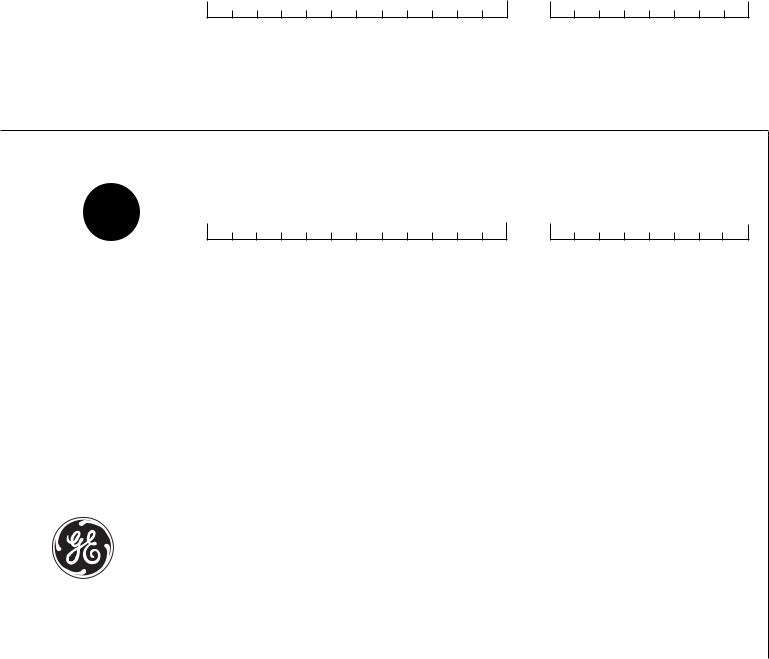
Consumer Product Ownership Registration
Dear Customer:
Thank you for purchasing our product and thank you for placing your confidence in us. We are proud to have you as a customer!
Follow these three steps to protect your new appliance investment:
Complete and mail |
2 |
After mailing the |
3 |
Read your Owner’s |
your Consumer |
registration below, |
Manual carefully. |
||
Product Ownership |
store this document |
It will help you |
||
Registration today. |
in a safe place. It |
operate your new |
||
Have the peace of |
contains information |
appliance properly. |
||
mind of knowing we |
you will need should |
|
||
can contact you in |
you require service. |
|
||
the unlikely event of a |
Our service number is |
|
||
safety modification. |
800 GE CARES |
|
||
1 |
(800-432-2737). |
|
||
|
Model Number |
Serial Number |
||
Important: If you did not get a registration card with your product, detach and return the form below to ensure that your product is registered, or register
online at ge.com.
Cut here
Consumer Product Ownership Registration
Important
Today!
Model Number |
Serial Number |
|
Mr. ■ |
Ms. ■ Mrs. ■ |
Miss ■ |
|
|
|
|
|
|
|
|
|
|
|
|
|
|
|
|
|
|
|
|
|
|
|
|
|
||||||
First |
|
|
|
|
|
|
|
|
|
|
|
|
Last |
|
|
|
|
|
|
|
|
|
|
|
|
|
|
|
|
|
|
|
|
|
|
|
|
|
|
|
|
|
|
|
|
|
|
|
|
|
|
|
|
|
|
|
|
|
|
|
|
|
|
|
|
|
|
||
Name |
|
|
|
|
|
|
|
|
|
|
|
Name |
|
|
|
|
|
|
|
|
|
|
|
|
|
|
|
|
|
|
|
|
|
|
Street |
|
|
|
|
|
|
|
|
|
|
|
|
|
|
|
|
|
|
|
|
|
|
|
|
|
|
|
|
|
|
|
|
|
|
|
|
|
|
|
|
|
|
|
|
|
|
|
|
|
|
|
|
|
|
|
|
|
|
|
|
|
|
|
|
|
|
|
|
|
Address |
|
|
|
|
|
|
|
|
|
|
|
|
|
|
|
|
|
|
|
|
|
|
|
|
|
|
|
|
|
|
|
|
|
|
|
|
|
|
|
|
|
|
|
|
|
|
|
|
|
|
|
|
|
|
|
|
|
|
|
|
|
|
|
|
|
|
|
|
|
|
|
|
|
|
|
|
|
|
|
|
|
|
|
|
|
|
|
|
|
|
|
|
|
|
|
|
|
|
|
|
|
|
|
|
Apt. # |
|
|
|
|
|
|
|
|
|
|
|
E-mail Address |
|
|
|
|
|
|
|
|
|
|
|
|
|
|
|
|
|
|
|
|
||
|
|
|
|
|
|
|
|
|
|
|
|
|
|
|
|
|
|
|
|
|
|
|
|
|
|
|
|
|
|
|||||
City |
|
|
|
|
|
|
|
|
|
|
|
|
|
|
|
|
State |
|
|
|
|
|
Zip |
|
|
|
|
|
|
|
|
|
||
|
|
|
|
|
|
|
|
|
|
|
|
|
|
|
|
|
|
|
|
|
|
|
|
|
|
|
|
|
|
|||||
|
|
|
|
|
|
|
|
|
|
|
|
|
|
|
|
|
|
|
|
|
Code |
|
|
|
|
|
|
|
|
|
||||
Date Placed |
|
|
|
|
|
|
|
|
|
|
|
|
|
Phone |
|
|
|
|
_ |
|
|
|
|
|
|
_ |
|
|
|
|
|
|
||
In Use |
|
|
|
|
|
|
|
|
|
|
|
|
|
|
|
|
|
|
|
|
|
|
|
|
|
|
|
|||||||
Month |
|
|
|
|
Day |
|
|
|
Year |
|
|
|
|
Number |
|
|
|
|
|
|
|
|
|
|
|
|
|
|
|
|
|
|
|
|
|
|
|
|
|
|
|
|
|
|
|
|
|
|
|
|
|
|
|
|
|
|
|
|
|
|
|
|
|
|
|||||
GE Consumer & Industrial
Appliances
General Electric Company Louisville, KY 40225 ge.com
*Please provide your e-mail address to receive, via e-mail, discounts, special offers and other important communications from GE Appliances (GEA).
■ Check here if you do not want to receive communications from GEA’s carefully selected partners.
FAILURE TO COMPLETE AND RETURN THIS CARD DOES NOT DIMINISH YOUR WARRANTY RIGHTS.
For information about GEA’s privacy and data usage policy, go to ge.com and click on “Privacy Policy” or call 800.626.2224.
14

Notes.
<![if ! IE]><![endif]>Instructions Safety
<![if ! IE]><![endif]>Instructions Operating
<![if ! IE]><![endif]>Tips Troubleshooting
<![if ! IE]><![endif]>Support Consumer
15
